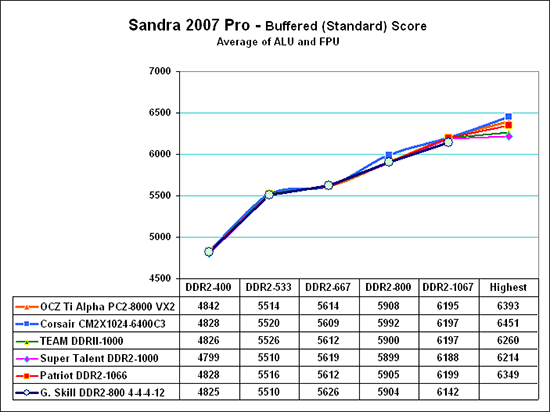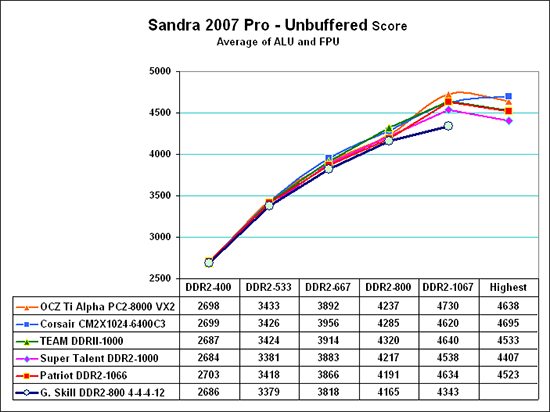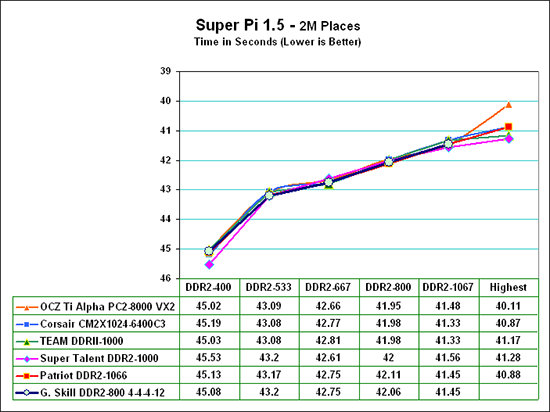Memory Bandwidth Scaling
Memory bandwidth normally improves with increases in memory speed and reductions in memory timings. This is best illustrated using Performance Scaling charts instead of the bar charts for individual speeds that were used in past memory reviews.
Since the results for high-end memory were so close at all tested speeds, the scale range was reduced to better show the small differences in these memory benchmark results. Please keep this in mind when viewing the charts, since a normal zero scale would make performance differences appear much smaller than these expanded scale charts. Maximum values for other memories at each speed are included in each chart for reference.
To evaluate memory bandwidth SiSoft Sandra 2007 Professional was used to provide a closer look at scaling for fast DDR2 memory.

The most widely reported Sandra score is the Standard or Buffered memory score. This benchmark takes into account the buffering schemes like MMX, SSE, SSE2, SSE3, and other buffering tools that are used to improve memory performance. Buffered bandwidth performance of the G.Skill memory was virtually the same as the previously tested high-end DDR2 memory to DDR2-800. Performance does drop a bit at DDR2-1066 due to the slower timings required of the mid-range G.Skill memory.
The Buffered benchmark does not correlate well with real performance differences in games, so our memory bandwidth tests have always included an Unbuffered Sandra memory score. The Unbuffered result turns off the buffering schemes, and we have found the difference in Unbuffered results correlate well with real-world performance differences.

In Unbuffered tests we see the G.Skill mirrors the best memory tested to DDR2-800. Performance does drop a bit if you run at slower timings and reduced voltage at DDR2-800. Again, at DDR2-1067, the penalty of 5-5-5 timings compared to 4-3-4 causes slightly lower results with the G.Skill. It is worth pointing out, however, that memory bandwidth, both buffered and Unbuffered, continues to increase with memory speed even though memory timings are a great deal slower at DDR2-1067.
We also compared results with Version 1.5 of Super Pi - comparing the time to calculate 2 million places of Pi at the different memory speeds. This benchmark measures pure number crunching.

Super Pi results continue to improve all the way to the highest speed that could be reached with stability with each memory. The second item that stands out is how very close the results with all the memories really are.. All 6 memories perform very similarly with just two exceptions. The G.Skill performs similarly until DDR2-1067 where slower timings finally provide a penalty. The Super Talent drops off a bit at the top and bottom due to slightly slower timings in those ranges. While performance is very close, Super Pi scaling charts continue to show the useful sensitivity of Super Pi as a measurement of memory performance
Memory bandwidth normally improves with increases in memory speed and reductions in memory timings. This is best illustrated using Performance Scaling charts instead of the bar charts for individual speeds that were used in past memory reviews.
Since the results for high-end memory were so close at all tested speeds, the scale range was reduced to better show the small differences in these memory benchmark results. Please keep this in mind when viewing the charts, since a normal zero scale would make performance differences appear much smaller than these expanded scale charts. Maximum values for other memories at each speed are included in each chart for reference.
To evaluate memory bandwidth SiSoft Sandra 2007 Professional was used to provide a closer look at scaling for fast DDR2 memory.

The most widely reported Sandra score is the Standard or Buffered memory score. This benchmark takes into account the buffering schemes like MMX, SSE, SSE2, SSE3, and other buffering tools that are used to improve memory performance. Buffered bandwidth performance of the G.Skill memory was virtually the same as the previously tested high-end DDR2 memory to DDR2-800. Performance does drop a bit at DDR2-1066 due to the slower timings required of the mid-range G.Skill memory.
The Buffered benchmark does not correlate well with real performance differences in games, so our memory bandwidth tests have always included an Unbuffered Sandra memory score. The Unbuffered result turns off the buffering schemes, and we have found the difference in Unbuffered results correlate well with real-world performance differences.

In Unbuffered tests we see the G.Skill mirrors the best memory tested to DDR2-800. Performance does drop a bit if you run at slower timings and reduced voltage at DDR2-800. Again, at DDR2-1067, the penalty of 5-5-5 timings compared to 4-3-4 causes slightly lower results with the G.Skill. It is worth pointing out, however, that memory bandwidth, both buffered and Unbuffered, continues to increase with memory speed even though memory timings are a great deal slower at DDR2-1067.
We also compared results with Version 1.5 of Super Pi - comparing the time to calculate 2 million places of Pi at the different memory speeds. This benchmark measures pure number crunching.

Super Pi results continue to improve all the way to the highest speed that could be reached with stability with each memory. The second item that stands out is how very close the results with all the memories really are.. All 6 memories perform very similarly with just two exceptions. The G.Skill performs similarly until DDR2-1067 where slower timings finally provide a penalty. The Super Talent drops off a bit at the top and bottom due to slightly slower timings in those ranges. While performance is very close, Super Pi scaling charts continue to show the useful sensitivity of Super Pi as a measurement of memory performance










30 Comments
View All Comments
christopherzombie - Sunday, November 5, 2006 - link
I have the same G.Skill "HZ" kit and I can do 1066mhz @ 5-5-5-15 with only 2.2v on an Abit AN9 32X 590SLI. I run at this speed 24/7 with my X2 4000+ @ 2.66ghz. No issues here. Great RAM for the money. I'm glad I didn't speed 50% more $$ for Cosair.formulav8 - Saturday, November 4, 2006 - link
I guess its just me, but I would think spending $300 for 2GB of memory is the absolute high-end prices. Even with the overall price increase of memory. I guess I am just poor :(Jason
Wesley Fink - Saturday, November 4, 2006 - link
Let's be VERY CLEAR. We are talking about TWO GIGABYTES of memory, which has become the new standard with Vista on the way. The absolute cheapest generic 2GB kit I could find on NewEgg runs am average of $200 - and it is generally DDR2-533. You can find Value DDR2-800, rated at 5-5-5 which we mention in the review, for $210 to $250. The DDR2-800 4-4-4 we tested was $299 - $99 more than the average low-end 2GB kit we could find at a reputable e-tailer. It also does 3-3-3 at 800 and 1067 since it is based on Micron D9 chips - if you can supply the voltage.YOU have to decide if it is worth it to spend $99 more for higher rated memory that can do 3-3-3 at DDR2-800 with voltage, 4-4-4 with no voltage, and DR2-1066. If you are shopping for a 1GB kit, the cost for 2x512MB is about half this amount. Until the move to DDR2, we always tested a 1GB kit. We moved the total up when 2GB became more common and it was clear Vista would need 1GB as a minimum.
xFlankerx - Saturday, November 4, 2006 - link
I think people aren't realizing that this is DDR2-800 memory, not DDR2-533. As such, it is Overclocking memory, and the prices are proportional to what the prices were for, say, a DDR600 memory kit for the AMD platform.I have the utmost respect for AT reviews, and your analyses, but when I read "Mid-Range" and saw the pic of the GBHZs (my favorite memory, from the AMD days), that left me a bit confused. I design PCs for others as a hobby, as do many many other people. And anyone who does knows that very few people are going to be willing to spend $300 on memory that they don't really need. Also, I'm a huge proponent of Memory Dividers, as they help majorly, and don't make you sacrifice performance.
The prices for the enthusiast memory may be proportional, however they are still VERY high. The massive FSB potential and overclocking of the Core 2 Duos has made it mandatory that you use high-speed memory in your system. DDR2-533 simply won't overclock far enough. So we HAVE to use DDR2-800 like we used DDR400. And with Vista requiring 2GB, the memory prices need to be much LOWER than they are right now. Going from $100 for 1GB DDR400 for a smooth and overclocked system, to needing to spend $250 for 2GB DDR2-800 for a smooth and overclocked system is a hard slap in the face for most people, including designers. As one of the people I was designing for pointed out, "Its a sad day when your memory costs more than your processor."
xsilver - Sunday, November 5, 2006 - link
I would just like to clear up something further as their are many conflicting views.is it possible to use ddr667 ram and still not hit the wall with your ram until 500FSB or so?
Using dividers of course, and taking the 5% hit in performance? (its not even 5% is it?)
Isnt this the best way to build a overclocking system on a budget?
I agree with Wes when he says that this ram is really only $99 more expensive than base ram but I guess its just the sad state that the ram market is in and people are looking for the best value they can. So categorizing $300 ram as "semi-performance" ram is just sad to see.
Steve Guilliot - Friday, November 3, 2006 - link
... "paying through the nose gets you miniscule performance gains"?The core architecture has never been memory bandwidth starved, and every single memory article seems to re-inforce that. Why didn't Wesley use 0 fps as the baseline for his scatter plots? Becuase if he did, the results wouldn't be exaggerated enough to notice on the graph. Doesn't that tell you something?
Sorry, but 1% gain is not worth spending and extra $200 on 1066 memory. That would be useful advice that needs to be reinforced when the money could be spent on better graphics or processing or monitor. Instead, the enthusiast community seems bent on justifying it's fascination with fast memory.
Look, memory was important with the P4, but let's move on and recognize that Core does not need fast memory.
Sorry for the soapbox, and this is not just a problem with Anandtech; it's on all the enthusiast sites.
JarredWalton - Friday, November 3, 2006 - link
High quality memory is important for overclocking. If your RAM can't go beyond DDR2-800, an E6300 would be limited to a maximum OC of 2.8 GHz - still fast, but a lot of people are hitting 3.2GHz+. An E6400 would be able to hit 3.2 GHz at DDR2-800 (with 1:1 ratio), and again you can almost certainly go further.As Wes states on page 5: "Memory speed can definitely improve system performance, but not to the extent of an upgraded video card or a higher speed processor." If you've already maxed out the other areas, or at least come close, then you will probably be willing to spend more on RAM as well. If you're pinching pennies elsewhere, then RAM is probably not going to be something you want to spend a ton on either. Of course, these days $300 for good quality 2GB kits isn't really that bad.
Steve Guilliot - Saturday, November 4, 2006 - link
Also, even if someone had "maxed" out other areas, I still wouldn't recommend throwing away money on faster RAM. If you're even above entry level, then you have at least a x9 multiplier. DDR2-667 will be fine for maintaining the ideal 1:1 divider while overclocking. Ok, let's stretch it to DDR2-800 for giggles. But DDR2-1066? Please.I suppose a fool is easily seperated from their money, but most people who have money value it. My recommendations alway involve eliminating waste no matter how much someone is willing to spend.
Steve Guilliot - Saturday, November 4, 2006 - link
So, you would recommend $300 RAM to someone who couldn't afford to pay more than $163 for an e6300, or $200 for an e6400? ... and e6600's are only $280.The statement "Memory speed can definitely improve system performance" is what set me off in the first place, since it is a gross exaggeration and underpins the focus of the article. I know the enthusiast community is a benchmark driven one, but cmon: 1% is not a definite improvement. Consistent maybe, but "definite" implies "noticable". Nope, 1% is not noticeable.
On a related note, most of my ranting is equally applicable to the quest for ever-higher FSB's.
xsilver - Friday, November 3, 2006 - link
cant u use memory dividers instead?I dont have a core system, but I would suspect that you can run something close to ddr 800 at 400fsb?
and then use the extra saved cash for a better video card/cpu?